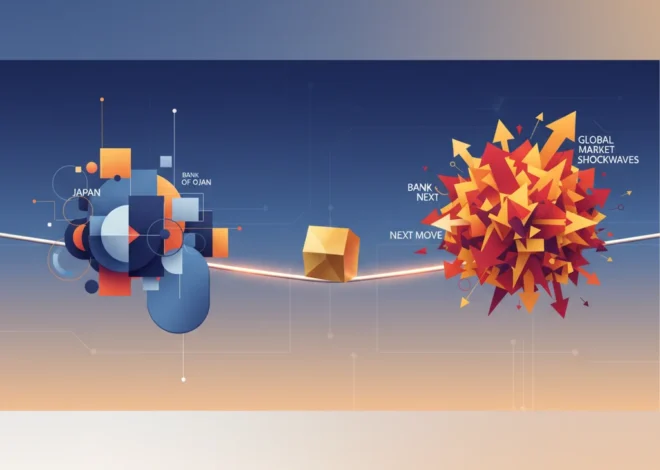
The AI Gold Rush: Why Asia’s Chip Titans May Be First to Feel the Chill
The global stock market has been captivated by the artificial intelligence revolution, a seismic shift that has sent technology valuations into the stratosphere. At the heart of this boom are the companies forging the literal building blocks of AI: the advanced semiconductors. Investors have poured capital into these “picks and shovels” of the digital gold rush, with Taiwanese and Korean chipmakers seeing their stock prices surge to unprecedented heights. But as the euphoria continues, a critical question for anyone involved in investing or tracking the global economy emerges: how sustainable is this rally, and who is most exposed when the cycle inevitably turns?
While US tech behemoths like Microsoft and Google are celebrated as the faces of the AI era, the foundational hardware is overwhelmingly produced by a handful of specialized Asian firms. This concentration creates a precarious imbalance. The argument, supported by deep market analysis, is that the very specialization that made these Asian giants indispensable also makes them uniquely vulnerable. When the frenetic pace of AI hardware spending cools, it is they, not their diversified American customers, who will likely face the first and most severe correction. This isn’t a question of if, but when—and understanding the dynamics is crucial for navigating the future of technology and finance.
The Anatomy of the AI Supply Chain: A Concentrated Power Structure
To grasp the underlying risk, one must first understand the structure of the AI hardware supply chain. It’s not a monolithic entity but a symbiotic relationship between a few key players, each with a distinct role.
- The Architect (USA): Companies like Nvidia design the world’s most advanced graphics processing units (GPUs), the “brains” behind large language models. They own the intellectual property and the brand but outsource the manufacturing.
- The Foundry (Taiwan): Taiwan Semiconductor Manufacturing Co. (TSMC) is the world’s preeminent contract chip manufacturer. They take Nvidia’s designs and use their unparalleled fabrication technology to turn them into physical silicon. As one analyst noted, TSMC’s stock has soared by more than a third this year alone, a testament to its critical role (source).
- The Memory Makers (South Korea): Firms like SK Hynix and Samsung are leaders in producing high-bandwidth memory (HBM), a specialized type of RAM essential for AI processors to access data at lightning speed. The demand for HBM has been so intense that SK Hynix, a key supplier to Nvidia, saw its shares jump by 45% in just a few months (source).
This ecosystem has created enormous wealth and technological progress. However, it also means that the fortunes of TSMC and SK Hynix are almost entirely tethered to the capital expenditure budgets of a small number of American cloud computing giants—namely Microsoft, Google, Amazon, and Meta—who are the primary buyers of these AI chips.
The Diversification Divide: Why US Tech Can Weather the Storm Better
The core of the risk lies in a fundamental difference in business models. The US tech giants who buy the chips are vastly more diversified than the Asian companies that make them. For Microsoft, AI is a powerful new engine to supercharge its existing suite of products: Azure cloud services, Office 365, and Windows. For Google, it enhances its dominant search and advertising businesses. AI is a massive investment, but it’s one of many pillars supporting their colossal enterprises.
Conversely, for a company like TSMC, advanced chip manufacturing isn’t just a pillar; it’s the entire skyscraper. Their revenue is a direct function of global demand for cutting-edge semiconductors. For SK Hynix, the HBM market is its golden goose. This hyper-specialization is a double-edged sword. In a boom, it leads to explosive growth. But in a downturn, there is no other business segment to cushion the fall.
The following table illustrates this strategic divergence:
| Feature | US Tech Giant (e.g., Microsoft) | Asian Chipmaker (e.g., TSMC) |
|---|---|---|
| Primary Business Model | Diversified software, cloud services, hardware, and advertising. | Specialized contract manufacturing of semiconductors. |
| Role in AI Value Chain | End-user and service provider; integrates AI into products. | Critical supplier; manufactures the core hardware. |
| Revenue Streams | Multiple, independent streams (SaaS, IaaS, Ads, Licensing). | Primarily dependent on fabrication orders from a few large clients. |
| Exposure to Hardware Cycle | Indirect. A downturn affects a capital expenditure line item. | Direct and immediate. A downturn means idle factories and lost revenue. |
This contrast is stark. If demand for AI servers dips, Microsoft’s Azure growth might slow, but its Office subscription revenue remains stable. If the same dip occurs, TSMC’s multi-billion dollar fabrication plants (fabs) risk running below capacity, directly impacting profitability. This is a classic lesson in investing: diversification mitigates risk.
Furthermore, there’s a geopolitical layer here that can’t be ignored. The concentration of the semiconductor supply chain in Taiwan and South Korea is already a major geopolitical fault line. A cyclical downturn in the chip industry could exacerbate economic and political tensions in the region, creating a feedback loop that further spooks the global stock market. Investors aren’t just betting on technology; they’re betting on a stable geopolitical environment to support this fragile, hyper-concentrated supply chain. The risk is compounded.
The Inevitable Cycle: Lessons from Semiconductor History
The semiconductor industry is notoriously cyclical. It’s a history of exhilarating booms followed by painful busts. This cycle is driven by the massive upfront investment required to build new fabs, which can cost upwards of $20 billion and take years to come online. Companies place these bets based on future demand projections.
During a boom like the current AI frenzy, everyone rushes to add capacity to avoid missing out. But demand is rarely a straight line. When a new technology matures, or an economic slowdown occurs, those optimistic projections can quickly evaporate. The result? A glut of capacity, falling prices, and decimated profits. According to the FT, some analysts are already warning that the current “super-cycle” is driven by a narrow base of demand from just a few US companies, making it inherently fragile (source).
The transition from the current hardware-building phase to a software-and-application phase will be a critical test. Once the foundational infrastructure is built out, the pace of hardware orders will naturally slow and shift toward maintenance and efficiency gains. This is the moment the cycle will turn, and the pure-play hardware manufacturers will feel it first. The world of financial technology and digital banking, for example, will continue to integrate AI, but their spending on the underlying infrastructure won’t grow exponentially forever.
Bitcoin's Crossroads: Decoding the Megaphone and Death Cross Warning Signs
Implications for Investors and the Global Economy
For those engaged in trading and long-term investing, this analysis offers several crucial takeaways. The AI narrative is not a monolith; it’s a complex ecosystem with varying levels of risk and reward.
- Look Beyond the Hype: It’s essential to differentiate between the technology’s long-term potential and the short-term investment cycle. While AI is here to stay, the valuations of companies in the supply chain can and will fluctuate wildly.
- Understand the Business Model: A company’s resilience is often determined by its diversification. Investing in a specialized manufacturer carries a different risk profile than investing in a diversified software giant that uses its products.
- Price in Cyclicality: The current market seems to be pricing in perpetual, exponential growth for chipmakers. A prudent investor should consider the industry’s historical cyclicality and the potential for a reversion to the mean.
On a macroeconomic scale, a downturn in the Asian semiconductor sector would have significant ripple effects. The economies of Taiwan and South Korea are heavily reliant on these tech exports. A sharp contraction could impact their GDP, employment, and currency stability, sending shockwaves through the global supply chain and affecting everything from cars to consumer electronics.
Beyond the Headlines: Decoding the £22 Energy Bill Drop and Its Ripple Effect on the UK Economy
Conclusion: Navigating the Maturation of AI
The artificial intelligence revolution is real and transformative. It is reshaping industries and creating immense value. However, the initial gold rush phase—characterized by a frantic build-out of hardware infrastructure—is subject to the fundamental laws of economics and market cycles.
The very companies that have benefited most spectacularly from this phase, the specialized chipmakers of Asia, are also the most exposed to its eventual cooling. Their lack of diversification places them at the front line of any downturn in capital spending by their US tech customers. For investors, business leaders, and policymakers, the message is clear: while the long-term promise of AI is undeniable, the path forward will not be a straight line up. Recognizing where the cyclical risks are most concentrated is the first step to navigating the next, more mature phase of the AI era.

